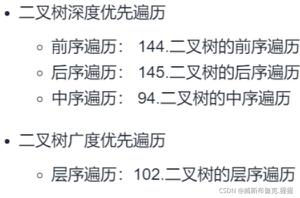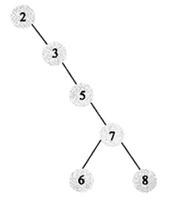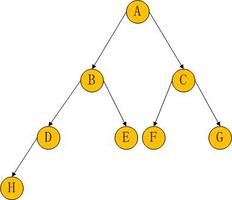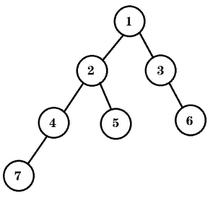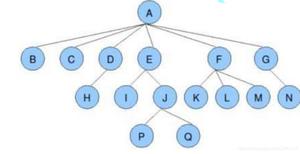Java实现二叉树先序,中序,后序,层次遍历

一、以下是我要解析的一个二叉树的模型形状。本文实现了以下方式的遍历:
1、用递归的方法实现了前序、中序、后序的遍历;
2、利用队列的方法实现层次遍历;
3、用堆栈的方法实现前序、中序、后序的遍历。
。
二、遍历
1、首先创建节点类
public class Node { private int data;
private Node leftNode;
private Node rightNode;
public Node(int data, Node leftNode, Node rightNode){
this.data = data;
this.leftNode = leftNode;
this.rightNode = rightNode;
}
public int getData() {
return data;
}
public void setData(int data) {
this.data = data;
}
public Node getLeftNode() {
return leftNode;
}
public void setLeftNode(Node leftNode) {
this.leftNode = leftNode;
}
public Node getRightNode() {
return rightNode;
}
public void setRightNode(Node rightNode) {
this.rightNode = rightNode;
}
}
View Code
2、递归方式实现前序、中序、后续遍历
public class BinaryTree { /**
* @author yaobo
* 二叉树的先序中序后序排序
*/
public Node init() {//注意必须逆序建立,先建立子节点,再逆序往上建立,因为非叶子结点会使用到下面的节点,而初始化是按顺序初始化的,不逆序建立会报错
Node J = new Node(8, null, null);
Node H = new Node(4, null, null);
Node G = new Node(2, null, null);
Node F = new Node(7, null, J);
Node E = new Node(5, H, null);
Node D = new Node(1, null, G);
Node C = new Node(9, F, null);
Node B = new Node(3, D, E);
Node A = new Node(6, B, C);
return A; //返回根节点
}
public void printNode(Node node){
System.out.print(node.getData());
}
public void theFirstTraversal(Node root) { //先序遍历
printNode(root);
if (root.getLeftNode() != null) { //使用递归进行遍历左孩子
theFirstTraversal(root.getLeftNode());
}
if (root.getRightNode() != null) { //递归遍历右孩子
theFirstTraversal(root.getRightNode());
}
}
public void theInOrderTraversal(Node root) { //中序遍历
if (root.getLeftNode() != null) {
theInOrderTraversal(root.getLeftNode());
}
printNode(root);
if (root.getRightNode() != null) {
theInOrderTraversal(root.getRightNode());
}
}
public void thePostOrderTraversal(Node root) { //后序遍历
if (root.getLeftNode() != null) {
thePostOrderTraversal(root.getLeftNode());
}
if(root.getRightNode() != null) {
thePostOrderTraversal(root.getRightNode());
}
printNode(root);
}
public static void main(String[] args) {
BinaryTree tree = new BinaryTree();
Node root = tree.init();
System.out.println("先序遍历");
tree.theFirstTraversal(root);
System.out.println("");
System.out.println("中序遍历");
tree.theInOrderTraversal(root);
System.out.println("");
System.out.println("后序遍历");
tree.thePostOrderTraversal(root);
System.out.println("");
}
}
View Code
3、借助队列实现层次遍历
//层次遍历public void theLeverTraversal(Node root) {
if (root == null) {
return;
}
//新建一个队列,LinkedList实现了Quene接口,可以直接当作队列来用
LinkedList<Node> queue = new LinkedList<Node>();
Node current; //当前节点
queue.offer(root);//根节点入队列
while (!queue.isEmpty()) {
current = queue.poll(); //取出队列的头节点
System.out.print(current.val + " ");//输出队列的头节点的值
if (current.left != null) {
queue.offer(current.left); //如果当前节点的左节点不为空,则左节点入队列
}
if (current.right != null) {
queue.offer(current.right); //如果当前节点的右节点不为空,则右节点入队列
}
}
}
View Code
4、堆栈方式实现前序、中序、后续遍历
public class BinaryTree1 { public Node init() {//注意必须逆序建立,先建立子节点,再逆序往上建立,因为非叶子结点会使用到下面的节点,而初始化是按顺序初始化的,不逆序建立会报错
Node J = new Node(8, null, null);
Node H = new Node(4, null, null);
Node G = new Node(2, null, null);
Node F = new Node(7, null, J);
Node E = new Node(5, H, null);
Node D = new Node(1, null, G);
Node C = new Node(9, F, null);
Node B = new Node(3, D, E);
Node A = new Node(6, B, C);
return A; //返回根节点
}
public void printNode(Node node){
System.out.print(node.getData());
}
public void theFirstTraversal_Stack(Node root) { //先序遍历
Stack<Node> stack = new Stack<Node>();
Node node = root;
while (node != null || stack.size() > 0) { //将所有左孩子压栈
if (node != null) { //压栈之前先访问
printNode(node);
stack.push(node);
node = node.getLeftNode();
} else {
node = stack.pop();
node = node.getRightNode();
}
}
}
public void theInOrderTraversal_Stack(Node root) { //中序遍历
Stack<Node> stack = new Stack<Node>();
Node node = root;
while (node != null || stack.size() > 0) {
if (node != null) {
stack.push(node); //直接压栈
node = node.getLeftNode();
} else {
node = stack.pop(); //出栈并访问
printNode(node);
node = node.getRightNode();
}
}
}
public void thePostOrderTraversal_Stack(Node root) { //后序遍历
Stack<Node> stack = new Stack<Node>();
Stack<Node> output = new Stack<Node>();//构造一个中间栈来存储逆后序遍历的结果
Node node = root;
while (node != null || stack.size() > 0) {
if (node != null) {
output.push(node);
stack.push(node);
node = node.getRightNode();
} else {
node = stack.pop();
node = node.getLeftNode();
}
}
System.out.println(output.size());
while (output.size() > 0) {
printNode(output.pop());
}
}
public static void main(String[] args) {
BinaryTree1 tree = new BinaryTree1();
Node root = tree.init();
System.out.println("先序遍历");
tree.theFirstTraversal_Stack(root);
System.out.println("");
System.out.println("中序遍历");
tree.theInOrderTraversal_Stack(root);
System.out.println("");
System.out.println("后序遍历");
tree.thePostOrderTraversal_Stack(root);
System.out.println("");
}
}
View Code
-------------------------------------------------------------------------------------------------------------------------
参考链接:
http://www.cnblogs.com/yaobolove/p/6213936.html
二叉树遍历(前序、中序、后序、层次、深度优先、广度优先遍历):https://blog.csdn.net/yimingsilence/article/details/54783208
以上是 Java实现二叉树先序,中序,后序,层次遍历 的全部内容, 来源链接: utcz.com/z/392903.html

